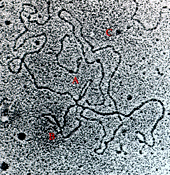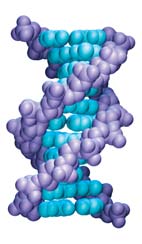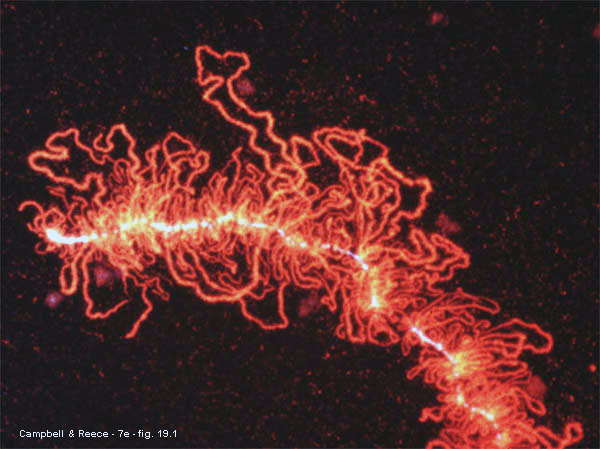The Genome and Genome Evolution:
- GENOME
is
an organism's complete set of genes
containing all info to build that
organism.
- GENOMICS
studies whole sets of genes
and their interactions within and between species.
- BIOINFORMATICS is the application of
computer methodologies to analyze vast genomic data.
What can GENOMIC ANALYSES
tell us? Sequenceing can tell us what
genes can make*
 "Sequencing
of the Human genome is comparable to the
establishment of the "Sequencing
of the Human genome is comparable to the
establishment of the
Periodic Table of elements by a Russian
chemist, Dimitri Mendeleev, 1869".
Genomics
began with the Human
Genome Project a 15
year 'JFK
moon-like' project...
HGP was initiated in 1990 by NIH & DOE and
involved 20 sequencing labs in 6 countries.
A 1st sequence was announced in 2003 and a more
complete sequence was published in 2006.
Genome Sequencing Procedures:
1. Frederick Sanger (Cambridge U.) in 1975
produced 1st complete sequence of a viral
genome of phage
ΦΧ-174
(5,375 np's) -
followed by human mitochondrion
with 17K np's.
2. Sanger's dideoxy*method*
of "Chain
Termination" -->
reading*
+ sequencing
labs*
uses termination nucleotides for they randomly stop
action of polymerase
when they are incorporated into growing chain
marking its end.
Strategy
- the Shotgun procedure*
& Celera Genomics
shotgun - video*
random DNA
fragments (from a library 500-800n long) are
sequenced using automated
sequencing machines & then ordered relative to
each other via overlap & supercomputing.
3.
Next
Generation Sequencing, then Minion
sequencing*
MK1-Minion*
MinION portable
DNA/RNA sequencer (~$1,000 to $50K+)*

Timeline: a 1st draft of
the Human genome sequence was announced*
in June 2000 and
by 2003 (13thyr) a 1st human genome sequence
was published (cost = ~ $3 billion).
2007 - Craig - Venter's Genome (dideoxy
method) ~ $7mil
($10 per 1,000 bases).
2008 - James Watson's genome
~ $1mil (20¢ per 1,000 bases)
2009 -
an EBay
bidder paid $68,000 for sequencing his
genome.
Costs: NHGRI cost
estimates: - per million
bases*
&
per
genome*
[table
of costs]
$1,000
genomes and Genome Testing?
=
Genealogy Testing*
= Your Ancestry DNA
+ 23and me
&
Genewiz whole genome
analysis &
Novogene Sequencing
Even a Human fetal genome has been
sequenced
the Future of Medicine*
27 May, 2021: A more Complete Human Genome
Sequence*
10 May
2023: a
draft Human Pangenome reference*
Genome
Sequencing
Standards
--> NIST
Reference Standards
Organisms: Early
list of organisms whose genomes are sequenced*
Databases: GenBank - an NIH database
of publically available DNA sequences

What we've learned from
sequencing the Human Genome...
Using methods for cloning
DNA fragments, automated DNA sequencing
techniques,
& computer algorithms
to piece together the entire genome sequences of
humans,
many viruses, bacteria,
archaea, yeast, C.elegans, Drosophila, & mouse
are known.
Surprising
Size Estimates of active Human Genome*
Originally estimated to be 100,000 genes,
current estimates list only some 20,687
protein
coding loci.
Comparison of genome
sizes for
complexity in model organisms
the Human Genome differs
by only 0.1% from
person to person.
The number of Human genes will depend upon how
we DEFINE a
"GENE"?
Some
Definitions of a Gene include:
Mendel's
Particles...
unit of heredity responsible for phenotype
term Gene was coined by Wilhelm Johanssen (1909)
to describe whatever it was that parents
passed to offspring to develop same traits (a
definition completely free of any hypothesis).
Morgan's
Loci... his research placed genes on a
chromosome, i.e.,
it's a cellular entity, that is part of chromosome & is mapable to a gene
LOCUS.
Watson
& Crick... provided a structure of
specific nucleotides
along length of double helical
DNA
Molecular Definition...
length: 1 nucleotide = 0.34nm
thus tRNA = 81n x 0.34 =
27.5nm
mass: 1 nucleotide = 340amu thus tRNA = 81n x 340 =
27,540amu
ex %: 20% A : 20% T : 30% G :
30% C
[A:T & G:C]
a Functional GENE
Definition... a DNA sequence coding for specific
polypeptide**

...But any definition of a gene
would also need to include...
Split
Genes... presence
of Introns & Exons*
- eukaryotic
genes contain non-coding segments
(introns) and coding segments (exons - that make proteins)
Other DNA
pieces... any definition of a gene should
also include:
DNA segments that code for
rRNA, tRNA, snRNP's,
miRNA's &
also promoters, enhancer
segments, regulator genes, operator
sites?
Pseudogene... mutated DNA segments, no longer
making a protein [≈ 10-20K segments];
were once active, but
evolution has made them effectively inactive now.
non-coding DNA... 98% of Human genome does
not code*
for protein (regulatory functions?).
Encode Project - (ENCyclOpedia of Dna Elements) is a long term
[begun 2003]
research effort involving 440 researchers in 32
research lab that 30 papers and
1,600 data sets describing determine functions of
many DNA pieces that
identified protein coding genes, non-coding RNAs,
regulatry genes, and enhancers,
and promoters,along with DNA and histone
modifications.
consensus:
the more commonly used definition of
a GENE...
... traditionally... traces back to a mRNA transcript (exons) & back to its DNA...
... the smallest unit for an inherited trait,
a gene --> a
COLLECTION of EXONS.
or ≈
"a segment of DNA
corresponding to a single protein
(or set of alternate protein
variants)
or a single catalytic or
structural RNA molecule"

Genome Organization...
Size
of Human genome:
3
billion+ base pairs, equaling some
500,000 pages of journal Nature.
yet, there are only about 20,687 protein
coding genes.
in fact, only about 1.5% of the genome codes for
proteins, i.e, about
40,000,000 bases
Arrangement of genomes:
differs between Prokaryotes
and Eukaryotes*
Gene
Density*
is less in Humans than many species.
the
chromosome* How genes
are represented on chromosome maps*View@Home
the
structural organization of genome in eukaryotes
influences gene expression.
- some unique human DNA folded structures may
regulate gene action (i-motifs vs. hairpins*)
- packing & unpacking chromosomal DNA by special
proteins generates loops & coils opens
it to be copies, repaired, or expressed into
proteins.
Types of Human DNA* Mobile
Genetic Elements*
Human Genome
Statistics*
Gene
models for studying Human genetic diseases
U.M.
Biology Core Zebrafish Facility

SIB
BIOINFORMATICS...
is an
interdisciplinary field of science that develops
methods and software tools for
understanding biological data and to analyze and
interpret biological data.
Also
referred to as computational biology
bioinformatics applies statistics and
informational theory, computational methodologies
and algorithms.
BIOINFORMATICS*View
is a
way of deciphering your DNA*View
to understand life's diversity & genetic
diseases.
[Spencer Hall - software
engineer - UGa 2016-19]
The vast amount of genomic sequence data is stored
& organized in 2 large data banks:
the
GenBank at the NIH in Bethesda, MD and
the
EMBL Sequence Database at
European Molecular Biology Laboratory in
Heidelberg,
Germany. Both of these databases are available to
all via the internet.
other databases include:
NCBI
- National Center
for Biotechnology Information
CCDS
-
NCBI Consensus human & mouse protein
coding regions
USCS Genome
Browser - UC Santa Cruz
Genome Browser
Ensembl Browser
- a genome browser for vertebrate
genomes
the Wonder of DNA...
next presentation -
neurophysiology *
SKIP
MATERIAL BELOW

next presentation -
neurophysiology*
COMPARING
GENOMES...
- using bioinformatics to assess
gene actions across a whole genome tells us how they
work in consort
- different species comparison
reveals information on the evolutionary
history of life
- comparisons of embryonic gene
action in different species may tell us how the great
diversity of life
may have arisen.
DNA divergence may infer relatedness or diversity... Tree of Life - fig 21.17*
sequence divergence via genotyping
*
DNA conservation can infer what it means
to be a particular type of organism, e.g.,
- some 47% of 414 genes common in yeast and humans have similar
functions making
yeast a model organism for human genetics.
- similar genes from closely related species (humans,
chimps, mice, etc) can provide
clues about what characteristics it takes to be a mammal,
- while finding genes shared by chimps/humans, but not
rodents tells us about being a primate.
CHIMPS VS. HUMANS...
-
show 99% similar chromosome banding patterns*
- differ by ~ 1.2% of N's, but humans have many more
insertions and
repetitive
duplications, 1/3 of which are not in chimp DNA.
- Humans have more ALU elements (DNA pieces cut
by the ALU restriction endonulease),
and chimps have more retroviral provirus DNA not found in humans.

EVOLUTION of GENOMES... Mechanisms that lead to
Gene Diversity*
favor evolution.
Role of
transcription factors: some
examples:
Genes that code for transcription factors are
involved with many functions & seem to evolve
faster...
the FOXP2 gene (fig 21.8*)? it may be
involved in speech
in humans and other vertebrates:
Researches used knock-out gene mechanisms to silence mice genes involved in vocalizations
producing 3 genotypes: 2 normal copies, a
heterozygote, and 2 homozygous knock-outs
EXP
1: the homozygous knock-out had
brain abnormalities
the heterozygote had less brain abnormalities
the normal genes showed no abnormalities
EXP 2:
new mouse pups squeek/whistle vocalizations were
analyzed and absence
of a
functional gene reduced these vocalizations
The FOXP2 transcription
factor gene in Humans shows rapid change &
regulates vocalization genes
Mutations in the Human FOXP2 gene results in language
impairment
Human/Chimp FOXP2 gene sequences differ by only 2
amino acids,
and presumably may be involved in 'speech
development'
Recently sequenced Neanderthal DNA showed a FOXP2 gene... Could they
have spoken?
Human history is only ~ 200,000 years, thus human DNA
variations are small...
Most changes are SNPs (Single Nucleotide Polymorphisms)
fig
20.15*
& occur in about 1% of the human population
and about 1 in 100-300 NPs
Human genomes also show many regions of inversions,
deletions, & duplications.

EVO-DEVO
. EVOlutionary DEVOpmental
biology
is the area of genomics that compares the developmental
processes
of different organisms to infer the
ancestral relationships between them and how
developmental processes evolved.
Genomic analyses have reveals homology
where dissimilar organs, such as the EYES of
insects, vertebrates and molluscs, (long thought to
have evolved separately), are controlled by
similar genes, such as Pax-6. Such genes are ancient,
being highly conserved among
phyla and
generate the patterns which shape an embryo, and
ultimately form the body plan of the organism.
Pax-6 is
one of the Pax gene family which codes for the transcription factor protein Pax-6,
found in neural
ectodermal cells of the
forebrain/hindbrain/spinal cord & midbrain.
It helps "control" the development
of eyes* and other
sensory organs across many species.
e.g., Mouse Pax6 can trigger normal compound eye
development in Drosophila melanogaster.
and fly Pax6 genes
can trigger normal eye development in frogs.
Mouse and Human PAX6 have identical amino acid
sequences.
Many Evo-Devo
genes are structural genes, coding for enzymes common
to many organisms,
being expressed in different parts of the embryo and
at different stages of development, forming a
cascade of control of other regulatory genes and
structural genes on and off in a precise pattern.
New morphological features and ultimately new species
are produced by variations either when
these genes are expressed in a new pattern, or
when these genes acquire additional functions.
back
next lecture*
a short Pictorial Chronology of the Gene...
& Genetic
Milestones from Peas to now...

Genes
and Evolution:
Modern synthetic
Darwinian evolution
predicts that Natural Selection
over time can lead to permanent changes in the the DNA that is inheritable.
but recent studies
have evoked a new science called EPIGENETICS...
study of changes in
gene activity that do not involve alteration to
the genetic code,
but changes that are still are passed to at least one successive
generation.
epigenetics changes the
DNA as a biological response to an environmental
stressor,
changes that can be
inherited through many
generations via epigenetic marks,
but if you remove the stressor epigenetic marks fade & the
DNA code will revert to normal.
somewhat Lamarckian (1744-1829) animals acquire traits
with their life span (giraffe).
ex: 1. drug
geldanamycin produces outgrowth of
Drosophila eyes that can last for 13
generations
no change is DNA sequences and generations 2-13 were
not exposed to drug.
2.
166 fathers who smoked before
age 11 had sons
who had a significantly higher BMI
than control kids of 14,024 fathers.
3. a diet rich in B-vitamins (folic acid & B12 - CH3 donors) fed to pregnant agouti mice
normal pups, but those w/o B-vitamins produces pus
with yellow coats & diabetes.
analogy: the genome is the hardware
and epigenetics is the software:
one can load windows on a Mac; you'll have the same
chip in the Mac (same genome)
but the software will produce a
different outcome - a different cell
type.
end.
 Home |About |News |Syllabus |Lecture-outlines |Links |FAQ |Sitemap |Contact
Home |About |News |Syllabus |Lecture-outlines |Links |FAQ |Sitemap |Contact
|
The index case for AMPD
deficiency was a 18 year old female
with calf pain that revealed a mis-sense mutation at nucleotide 143 in codon 48 of
exon 3 where C
changed to T
resulting in a change of proline
to leucine. This
mutant allele is found in 12% of Caucasians and
19% of African Americans and results in the AMPD deficiency in
muscle biopsies and results
in exercise-induced metabolic myopathy in
humans.
ref: A life Decoded by J. Craig Venter, Viking
Press, 2007, C2, pg 28
back
|
SKIP ALL OF THE MATERIAL BELOW THIS POINT...
Gene
expressions in
pharmacogenomics
&
toxicogenomics via microarrays
1 cM = about 1 Mb
TRANSPOSONS -
pieces of DNA prone to
moving & creating
repeat sequences
LINE
- long interspersed nuclear
element holds promoter & 2 genes: RT & integrase
an
anomaly - RNA Recoding*
|
 "Sequencing
of the Human genome is comparable to the
establishment of the
"Sequencing
of the Human genome is comparable to the
establishment of the





